Ziquejie Terraces, located in Shuiche Town, Xinhua County, Loudi City, Hunan Province, is a national 4A-level tourist attraction, a World Irrigation Engineering Heritage, and a national scenic spot. Featuring unique terrace farming culture, the scenic area boasts a gravity irrigation system with a history of over 2,000 years that still operates normally today. Covering a total area of approximately 80,000 mu (about 5,333 hectares) with a core area of 28,000 mu (about 1,867 hectares), the terraces stretch from 500 meters to 1,200 meters above sea level, consisting of more than 500 levels. It is a living fossil of the integration of southern rice cultivation culture and hunting culture, and also one of the top ten most beautiful terraces in the world.
History and Culture
Ziquejie Terraces were first built in the Pre-Qin Period and flourished in the Song and Ming Dynasties, with a history of over 2,000 years. They are an agricultural miracle co-created by ethnic groups such as the Miao, Yao, and Han. Research shows that the terraces were initially reclaimed by the ancestors of the Miao and Yao peoples, and later gradually improved with the southward migration of Han people from the Central Plains, forming the large-scale terrace system we see today.
The gravity irrigation system in the scenic area is hailed as "a miracle in the history of world water conservancy." It relies on fissure water from granite bedrock for self-flowing water supply without the need for artificial pumping, irrigating an area of 40,500 mu (about 2,700 hectares). It has been listed as a "Globally Important Agricultural Heritage System (GIAHS)" by the Food and Agriculture Organization (FAO) of the United Nations. This irrigation method ingeniously utilizes the local geological structure and natural height difference, embodying the wisdom of ancient agricultural civilization.
Ziquejie Terraces are not only a place for agricultural production but also a carrier of ethnic culture. The local area still retains traditional farming festivals such as the "Ploughing Festival" and "New Rice Tasting Festival," as well as folk activities like folk song duets and Nuo mask dances, showcasing the unique production and lifestyle of southern mountainous areas.
Major Attractions
Baguachong Viewing Platform
As the most beautiful and representative attraction in the scenic area, Baguachong Terraces are characterized by their small size, delicacy, agility, elegance, and beauty. Named after their resemblance to the Bagua diagram, they offer a charming view.
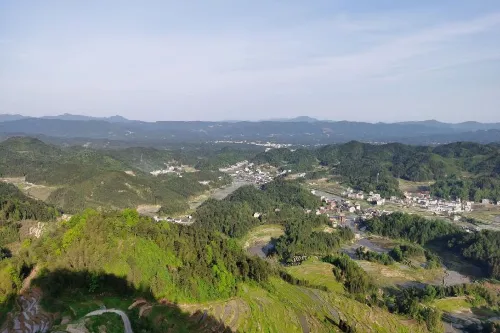
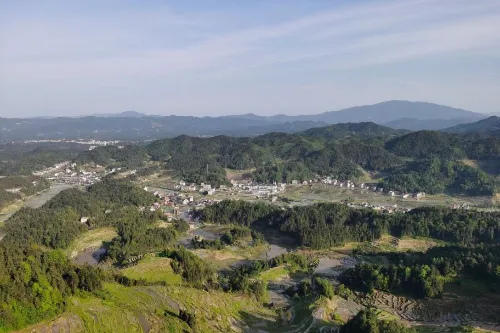
Yuèyáshān (Crescent Moon Mountain) Viewing Platform
The terraces at Yuèyáshān Viewing Platform feature smooth and flowing lines, resembling small crescent moons in the sky, hence the name Yuèyáshān (Crescent Moon Mountain).
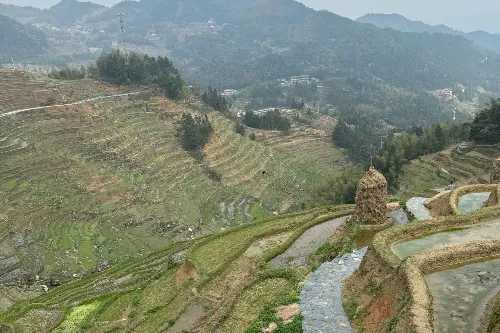
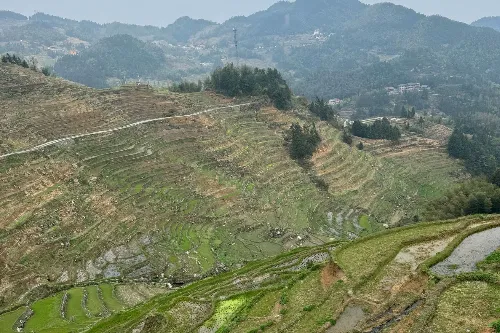
Yaorenchong Viewing Platform
According to archaeological investigations by cultural relic experts, historical sites such as Yaoren Dàng (Yao People's Pond), Yaoren Dòng (Yao People's Cave), and Yaoren Wūchǎng (Yao People's Courtyard) left by the Yao people have been found on the mountains here, hence the name Yaorenchong (Yao People's Valley).

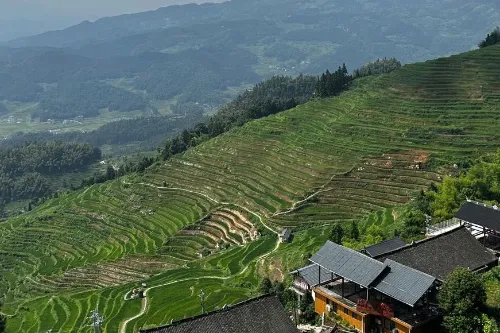
Jiulongpo Viewing Platform
Viewing the terraces from Jiulongpo offers an aesthetic experience of "Seeing ridges horizontally, peaks vertically; different views from far, near, high, and low." From a distance, nine mountain ridges loom faintly, resembling nine divine dragons vying to climb to the mountain top.

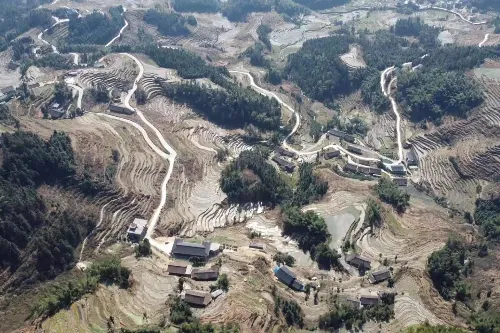
Yajizhai Viewing Platform
Yajizhai consists of two parts: Yajizhai Viewing Platform and Zique Pavilion. Located at the top of a mountain 1,200 meters above sea level, Zique Pavilion overlooks the entire terraced landscape. Yajizhai Viewing Platform, at an altitude of 1,080 meters, offers a panoramic view of Ziquejie Terraces.
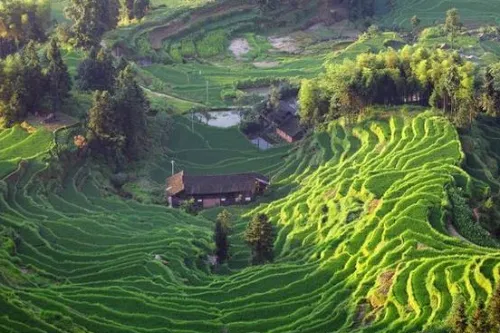
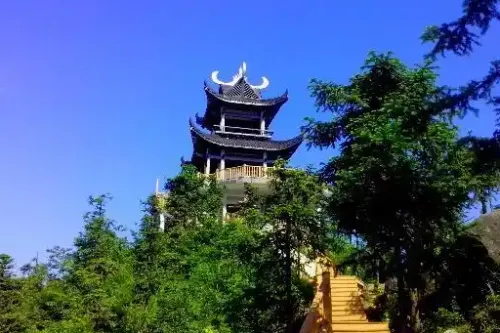
Zhenglong Ancient Village
A traditional Chinese village, a famous tourist village in Hunan Province, and a national beautiful and livable village, Zhenglong Ancient Village preserves more than 200 stilted wooden houses from the Ming and Qing Dynasties, scattered along the mountain slopes to form primitive courtyards. As a multi-ethnic settlement of Miao, Yao, and Han peoples, it boasts a long-standing Meishan culture and retains folk activities such as dragon and lion dances, Nuo opera, and folk songs.
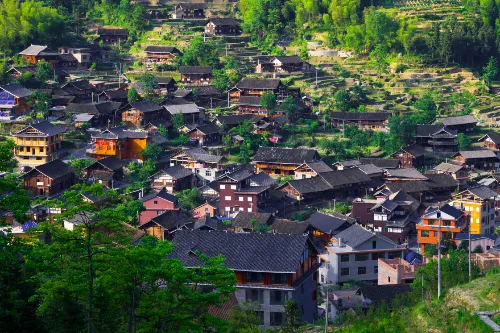
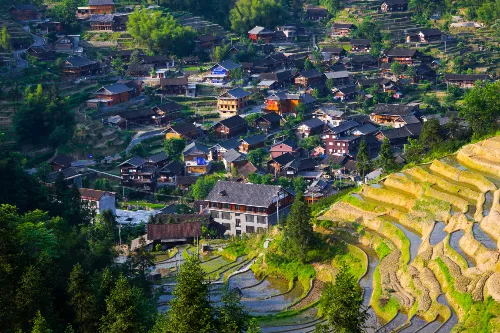
Tour Routes
Recommended Routes by the Scenic Area
Route 1: Baguachong Viewing Platform → Yaorenchong Viewing Platform → Yuèyáshān Viewing Platform → Zhenglong Ancient Village. Estimated duration: 5 hours.
Route 2: Yuèyáshān Viewing Platform → Yaorenchong Viewing Platform → Jiulongpo Viewing Platform → Yajizhai Viewing Platform → Zhenglong Ancient Village. Estimated duration: 5.5 hours.
Travel Tips
- The best visiting times are the irrigation period (April-May) and harvest season (September-October), when the terraces are either shimmering with water or covered in golden rice, offering the most stunning views.
- Bring a camera and tripod. Baguachong and Jiulongpo are ideal for photography, with the best light in the early morning and late afternoon.
- Most accommodations in the scenic area are farm stays. It is recommended to stay near Jiulongpo for convenient sunrise viewing the next day. Room rates are approximately 150-250 RMB per night (including breakfast).
- Advance reservations with the scenic area or homestays are required for agricultural activities such as rice transplanting (May), harvesting (October), and rice flower fish catching (August).
- Temperature differences between day and night in the mountainous area are significant. Bring a light jacket in summer and a down jacket in winter. Non-slip shoes are recommended as some terrace ridges are steep.
Notes
- Climbing the terraces randomly is prohibited to avoid damaging the ridges and crops. Violators may face a fine of 50-200 RMB.
- The last sightseeing bus departs at 17:30. Please arrange your time reasonably to avoid hiking downhill (some sections have no street lights).
- Respect local customs. For example, keep quiet when entering Yaorenchong Ancient Village and do not randomly photograph villagers' daily lives.
- Weather in the mountains is changeable. Carry an umbrella or raincoat. Fog is common from April to May, so please pay attention to traffic safety.
- It is recommended to purchase agricultural products at designated stores in the scenic area rather than roadside stalls. Bargaining is acceptable (e.g., for tribute rice and cured meat).
- There are many mosquitoes in summer, so take anti-mosquito measures. Some high-altitude roads may be icy in winter; self-driving vehicles should be equipped with snow chains.
Transportation
- High-Speed Railway: Take the high-speed train from Changsha South Station to Xinhua South Station (approximately 50 minutes, ticket price: 86 RMB). After exiting the station, take the Ziquejie tourist special line bus at the square in front of the station (operating hours: 8:00-17:00, one bus per hour, ticket price: 25 RMB, travel time: about 1.5 hours) to reach the scenic area directly.
- Long-Distance Bus: Tourist buses to Ziquejie Terraces are available from Changsha West Bus Station and Loudi Bus Station. The journey from Changsha takes about 3.5 hours with a ticket price of 80 RMB, while from Loudi it takes about 2 hours with a ticket price of 50 RMB. Minibuses from Xinhua County West Bus Station to the scenic area operate daily from 6:30 to 16:30, with a ticket price of 20 RMB and a travel time of 1 hour.
- Self-Driving: Changsha → Changsha-Shaoshan-Loudi Expressway → Xinhua Exit → Ziquejie Terraces (total distance: about 2.5 hours, toll fee: approximately 120 RMB); Loudi → Loudi-Huaihua Expressway → Xinhua Exit → Ziquejie Terraces (total distance: about 1.5 hours, toll fee: approximately 50 RMB). There are 4 large parking lots in the scenic area, with a parking fee of 10 RMB per vehicle per day.
- Internal Transportation: Sightseeing buses operate in a loop within the scenic area, stopping at major attractions such as Baguachong, Jiulongpo, and Yajizhai. Operating hours: 07:30-17:30. The fare is 20 RMB per person for unlimited rides throughout the day.
Opening Hours
Open year-round. Daily opening hours: 07:00-18:00. The best visiting seasons are April-May (irrigation period) and September-October (harvest season). The "Ploughing Festival" is held from April 20 to May 10, and the "Harvest Festival" from September 20 to October 10, during which agricultural experience activities and folk performances are held. Some high-altitude areas may be closed due to ice and snow in winter (December-February).
Ticket Information
Ticket price: 68 RMB per person.
Search for the official WeChat public account "紫鹊界梯田景区" to get the latest updates or purchase tickets online.
Online Booking
Click here to jump to the Trip.com ticketing platform for ticket purchase.


